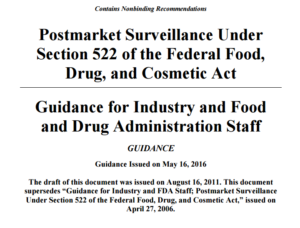 After five long years, FDA has finally issued the final guidance for medical postmarket surveillance requirements under section 522 of the Federal Food Drug and Cosmetic Act. The new guidance, issued today, 16 May 2016, shows a level of regulatory discipline not seen in some recent guidances, and outlines the statutory framework and basis for postmarket surveillance activities, and what manufacturer obligations are with respect to such activities. The Guidance expands upon the Draft Guidance issued in August, 2011 and follows the same basic structure and elements (although much expanded). This Guidance is an essential element of FDA’s public health protection mandate, to ensure that specific types and implementations of devices have an appropriate framework in place to identify and report on field medical device issues and problems.
After five long years, FDA has finally issued the final guidance for medical postmarket surveillance requirements under section 522 of the Federal Food Drug and Cosmetic Act. The new guidance, issued today, 16 May 2016, shows a level of regulatory discipline not seen in some recent guidances, and outlines the statutory framework and basis for postmarket surveillance activities, and what manufacturer obligations are with respect to such activities. The Guidance expands upon the Draft Guidance issued in August, 2011 and follows the same basic structure and elements (although much expanded). This Guidance is an essential element of FDA’s public health protection mandate, to ensure that specific types and implementations of devices have an appropriate framework in place to identify and report on field medical device issues and problems.
The authority for the requirement for postmarket surveillance goes back two decades, although guidance on the who, how, and when has been lacking complete definition, until now. The new Guidance provides the internal FDA process for the issuance of a Section 522 “order” outlining a requirement on behalf of a manufacturer to conduct device-specific postmarket surveillance activities, and, the process whereby manufacturers must submit their postmarket surveillance “plan”, within 30 days of the postmarket surveillance order.
The Guidance outlines the basic elements of the postmarket surveillance submission, including (see guidance for all elements):
- patient population (including subject inclusion and exclusion criteria and definition and source of comparator group)
- sample size calculation (statistically justified and based on study hypothesis, where applicable)
- primary and secondary endpoints (including definitions for endpoints, success criteria, a list of expected adverse events/complications, an agreement to collect unexpected adverse events, and a plan to assess relatedness of endpoints with the device and/or the procedure)
- length of follow-up, follow-up schedule, description of baseline, and follow-up assessments, where applicable
- description of data collection procedures (including recruitment plans, enrollment targets, plans to minimize losses to follow-up, follow-up rate targets, quality assurance, and control), where applicable, and
- statistical analysis
FDA will review, assess and approve or disapprove the plan. Given FDA’s clear statutory authority and length of time industry has had the Draft Guidance, it will be incumbent on manufacturers to be well prepared to develop robust plans with broad applicability, as failure to comply with the order and submit a plan to FDA’s approval is a prohibited act under the FFDCA, resulting in affected devices being misbranded under the Act.
All manufacturers should be sure they are familiar with the Final Guidance, and hopefully, they are already well down the path towards full compliance, given the five years of the Draft Guidance being in place. The final Guidance can be found here: Final Section 522 Order Guidance
